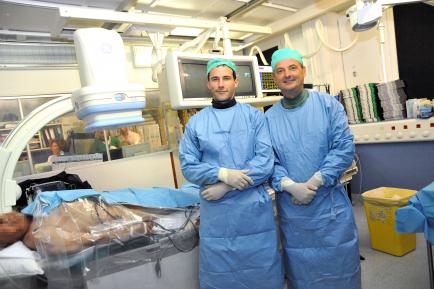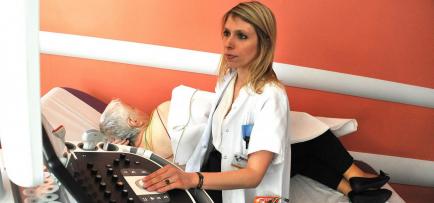Cardiogenic shock, pulmonary embolism: new high tech treatments at Hôpital Nord (Assistance Publique – Hôpitaux de Marseille)
The Hôpital Nord Cardiology Department is actively involved in medical innovation for patients with acute heart disease and vital prognosis. Two innovative devices reinforce the therapeutic arsenal available to patients.
IMPELLA against cardiogénic shock
Hôpital Nord is one of the regional referral centers for myocardial infarction. The cardiology department led by Pr. Franck PAGANELLI recently obtained the latest equipment for patients with the most severe form of myocardial infarction: cardiogenic shock. The heart muscle can no longer ensure its work, which causes severe hypotension leading to insufficiency of other organs: lungs, kidney, brain, liver, digestive system... The mortality rate is around 50%.
The team uses a cardiac assist device that is installed without surgery during coronary angiography (percutaneous) to temporarily supplement the defective heart. « This innovative device called IMPELLA has been used twice since the beginning of the year for patients with a cardiogenic shock related to an infarction. This cardiac assistance device made it possible to treat them effectively and they were able to return to their homes at the end of their treatment. » explains Pr. Laurent BONELLO, head of the intensive care unit in cardiology.
In collaboration with the SAMU 13, the cardiology department of the Hôpital Nord (AP-HM) is positioning itself as a key player in the Caracogenic Shock care network in the PACA region thanks to its expertise and technical facilities.
In situ ultrasound thrombolysis against severe pulmonary embolism.
Pulmonary embolism is one of the leading causes of death in France. The management of this condition resides in an anticoagulant treatment to reduce the risk of extension of thrombosis and recurrence, but the delay of action is rather long.
For the most critical cases, systemic thrombolysis (administered via a peripheral venous pathway) has been the only therapy capable of actively dissolving the thrombus (clot) responsible for pulmonary artery obstruction. However, this therapy is accompanied by a high haemorrhagic risk, in particular intracerebral, and is contraindicated for patients considered fragile.
In recent months, an in situ thrombolysis system with ultrasound has been available. This highly innovative, effective, easy to set up and safe device can drastically reduce the dose of thrombolytic used and consequently the risk of haemorrhage.
« A first patient benefited successfully from this new technique at the beginning of the year in the cardiology department. The patient was in a state of shock related to bilateral pulmonary embolism, which affected his life prognosis. Since thrombolysis is contraindicated in this case, he was able to benefit from the technique of the in situ thrombolysis catheter guided by ultrasound. The procedure was carried out without complications allowing a rapid improvement of his clinical condition: he was able to return home 4 days later without cardiac sequelae. » explains Pr. Laurent BONELLO.
To enable as many people as possible to benefit from this new technique, the Hôpital Nord cardiology department and the SAMU 13 are currently working on setting up a dedicated departmental department.
 The Hôpital Nord cardiology department has 2 specific units: Northern Unit Cardiac Insufficiency and Valvulopathies - UNIV and the Mediterranean Center Hospital-University Cardiology Oncology.
The Hôpital Nord cardiology department has 2 specific units: Northern Unit Cardiac Insufficiency and Valvulopathies - UNIV and the Mediterranean Center Hospital-University Cardiology Oncology.  The Mediterranean Cardiac Oncology Center (Medi-CO) is specialized in the management of cardiovascular diseases secondary to or associated with cancer treatments.
The Mediterranean Cardiac Oncology Center (Medi-CO) is specialized in the management of cardiovascular diseases secondary to or associated with cancer treatments. 